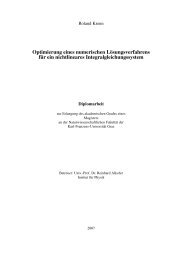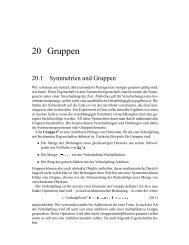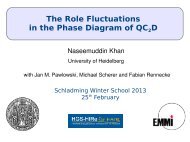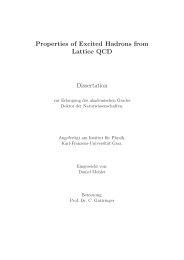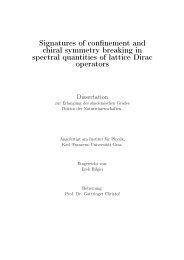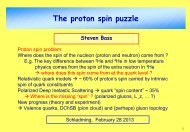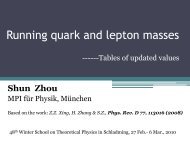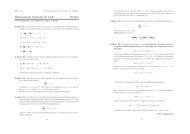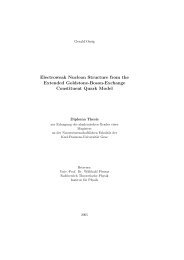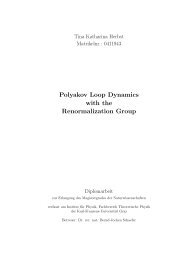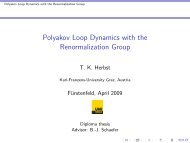The QCD Quark Propagator in Coulomb Gauge and - Institut für Physik
The QCD Quark Propagator in Coulomb Gauge and - Institut für Physik
The QCD Quark Propagator in Coulomb Gauge and - Institut für Physik
Create successful ePaper yourself
Turn your PDF publications into a flip-book with our unique Google optimized e-Paper software.
Chapter 2. Chiral Symmetry Break<strong>in</strong>g <strong>in</strong> <strong>QCD</strong> 7<br />
<strong>The</strong> matrices t r are a basis of the fundamental representation of SU(N f ). <strong>The</strong> result<strong>in</strong>g<br />
charges<br />
∫<br />
Q r L =<br />
∫<br />
Q r R =<br />
d 3 xJ r L0(x, t) , (2.9)<br />
d 3 xJR0 r (x, t) , (2.10)<br />
fulfil the same commutation relations as the generators of the Lie algebra of SU L (N f ) ×<br />
SU R (N f ). Under parity transformations they transform <strong>in</strong>to each other, PQ L P −1 = Q R ,<br />
which expla<strong>in</strong>s the name chiral transformations. <strong>The</strong> parity eigenstates are obta<strong>in</strong>ed by<br />
exam<strong>in</strong><strong>in</strong>g the diagonal subgroups SU L+R (N f ) <strong>and</strong> SU L−R (N f ) <strong>and</strong> the correspond<strong>in</strong>g<br />
currents:<br />
V r<br />
µ (x) = Jr Rµ (x) + Jr Lµ (x)<br />
= Ψ f (x)γ µ<br />
t r fg<br />
2 Ψg , (2.11)<br />
A r µ (x) = Jr Rµ (x) − Jr Lµ (x)<br />
= Ψ f (x)γ µ γ 5<br />
t r fg<br />
2 Ψg . (2.12)<br />
<strong>The</strong>y transform as vector <strong>and</strong> an axial-vector respectively under parity transformations.<br />
<strong>The</strong>ir time components fulfil the equal time commutation relations<br />
[V0 r s<br />
(x, t), V0 (y, t)] = ifrst V0 t (x, t)δ(3) (x − y) , (2.13)<br />
[V r<br />
0 (x, t), A s 0(y, t)] = if rst A t 0(x, t)δ (3) (x − y) , (2.14)<br />
[A r 0 (x, t), As 0 (y, t)] = ifrst V t<br />
0 (x, t)δ(3) (x − y) . (2.15)<br />
In these equations f rst are the antisymmetric structure constants of the Lie algebra of<br />
SU(N f ). <strong>The</strong> set of commutation relations is known as the current algebras. S<strong>in</strong>ce the<br />
left h<strong>and</strong> sides of the relations are quadratic <strong>in</strong> the currents <strong>and</strong> the right h<strong>and</strong> sides are<br />
l<strong>in</strong>ear, non-l<strong>in</strong>ear constra<strong>in</strong>ts for the currents follow. In particular their normalisation is<br />
determ<strong>in</strong>ed by these equations. <strong>The</strong>y also give rise (via the current algebra sum rules<br />
[IZ, CL, TW]) to relations between different cross sections of lepton-nucleon scatter<strong>in</strong>g,<br />
which are <strong>in</strong> good agreement with experiment.<br />
Explicit break<strong>in</strong>g of chiral symmetry is caused by the fermionic mass terms <strong>in</strong> the Lagrangian<br />
(2.1). Nevertheless chiral symmetry is a good approximation concern<strong>in</strong>g the light<br />
quarks due to the fact that their current quark masses are small compared to the typical<br />
energy scale of strong <strong>in</strong>teraction. For the strange quark the concept of an approximate



